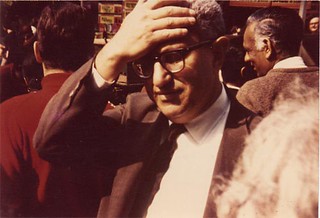Just east of West Broadway, a plaque on Prince Street honors Chester Rapkin as the “Father of SoHo.” In his New York Times obituary, Rapkin is credited with coining the term SoHo – a portmanteau of the phrase and area covering “SOuth of HOuston” street. It was a move that influenced the abbreviated nomenclature of other New York City neighborhoods from Tribeca (“TRIangle BElow Canal”) to Nolita (“NOrth of LIttle ITAly”) and Dumbo (“Down Under the Manhattan Bridge Overpass”).
The plaque reads:
Chester Rapkin
1918-2001
Father of SoHo
Scholar, City Planner, Visionary Urbanist, Who Transformed A Moribund Industrial Zone Into A Vital Artistic Commercial And Residential Community
New York City Planning Commissioner
1969-1977
Rapkin was an influential urban planning theorist and professor of Urban Planning at the University of Pennsylvania and then later Princeton. In 1962 a group called the Middle Income Cooperators of Greenwich Village (MICOVE) supported a plan to raze a considerable amount of SoHo and replace it with a middle-income housing project. At the request of the City Planning Commission, Rapkin studied the neighborhood. Rapkin found some businesses to be struggling and dealing with the inefficiencies of running a 20th century business in a 19th century structure. According to Rapkin’s study, 12,000 jobs – mostly consisting of manufacturing jobs for minority and women workers – existed in the neighborhood, in addition to a significant number of housing units and businesses. His study also pointed out that predominantly small industries occupied the neighborhood, and needed the inexpensive spaces. Hence, when trying to understand how to balance the competing needs of industrial tenants and artists, planners like Donald H. Elliot, former chairman of the Planning Commmision, were able to make distinctions based on building size, allowing smaller buildings for use by artists. My. Elliot also states that “this eventually led to the whole rezoning of SoHo, which has been very successful. Famed architect and dean emeritus of Princeton University’s School of Architecture Robert Geddes claims that this study “has been credited with saving that area from demolition.”
Rapkin’s study is also said to be instrumental in grassroots activists’ and urban planners’ fight in signifying the neighborhood’s viability in its provision of jobs, businesses, and housing for artists. It led to the LOMEX expressway and other projects being aborted. Eventually, the neighborhood, including Broadway, was successfully preserved; however, all these threats caused a decline in its value and maintenance. While SoHo was still zoned for manufacturing use and lacked many of the necessary amenities for residential purposes, its continued disinvestment created the opportunity for artists to move into empty lofts which provided enough affordable space in which they could work as well as live. While industry declined, the landscape of art was changing the neighborhood, and these artists instigated yet another cultural shift for SoHo.
Rapkin’s legacy lives on not only in the name of the neighborhood, but in what it has become today.
